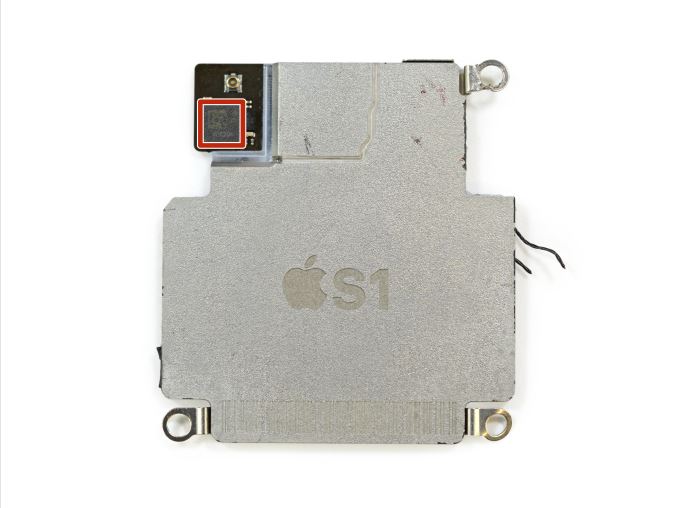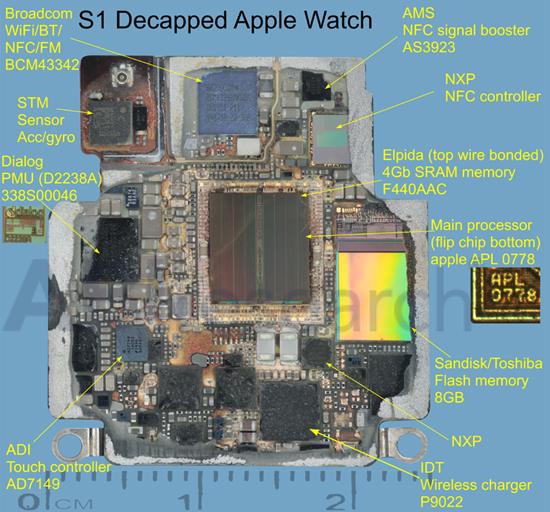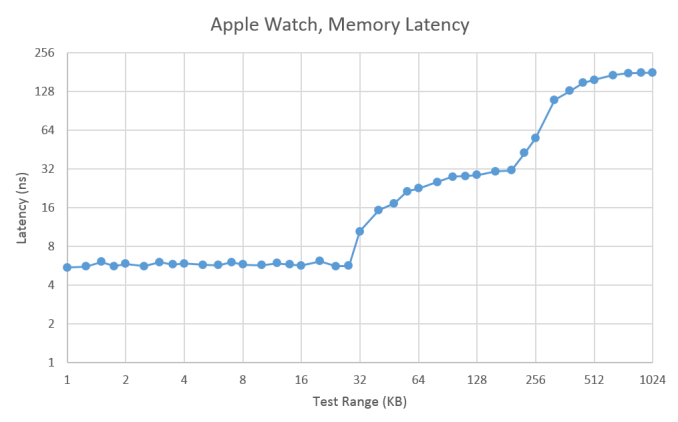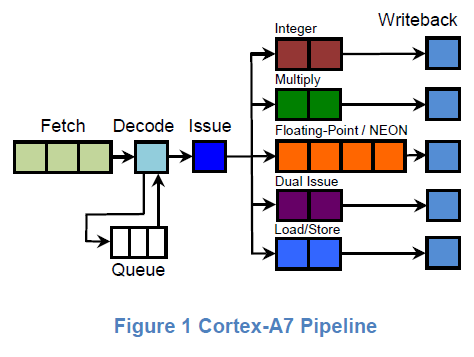The Apple Watch Review
by Joshua Ho & Brandon Chester on July 20, 2015 8:00 AM EST- Posted in
- Wearables
- Apple
- Mobile
- Apple Watch
Apple S1 Analysis
One of the biggest issues with the smartwatch trend that I’ve seen is that as a result of most companies entering the market with smartphone backgrounds, we tend to see a lot of OEMs trying to shove smartphone parts into a smartwatch form factor. There have been a lot of different Android Wear watches, but for the most part everything seems to use Qualcomm’s Snapdragon 400 without the modem. Even though A7 is relatively low power for a smartphone, it’s probably closer to the edge of what is acceptable in terms of TDP for a smartwatch. Given that pretty much every Android Wear watch has around a 400 mAh battery at a 3.8 or 3.85 volt chemistry to attempt to reach 1-2 days of battery life and a relatively large PCB, the end result is that these smartwatches are really just too big for a significant segment of the market. In order to make a smartwatch that can scale down to sizes small enough to cover most of the market, it’s necessary to make an SoC specifically targeted at the smartwatch form factor.

Capped Apple S1 SoC (Image Courtesy iFixit)
The real question here is what Apple has done. As alluded to in the introduction, it turns out the answer is quite a bit. However, this SoC is basically a complete mystery. There’s really not much in the way of proper benchmarking tools or anything that can be run on the Watch to dig deeper here. Based on teardowns, this SoC is fabricated on Samsung’s 28nm LP process, although it’s not clear which flavor of LP is used. It’s pretty easy to eliminate the high power processes, so it’s really just a toss-up between HKMG and poly SiON gate structure. For those that are unfamiliar with what these terms mean, the main difference that results from this choice is a difference in power efficiency, as an HKMG process has less leakage power. Given how little cost is involved in this difference in process compared to a move to 20/14nm processes, it’s probably a safe bet that Apple is using an HKMG process here especially when we look at how the move from 28LP to 28HPm at TSMC dramatically affected battery life in the case of SoCs like Snapdragon 600 and 800.

Decapped & Labeled S1 SoC (Image Courtesy ABI Research)
We also know that binaries compiled for the watch target ARMv7k. Unfortunately, this is effectively an undocumented ISA. We know that Watch OS is built on iOS/Darwin, so this means that a memory management unit (MMU) is necessary in order to make it possible to have memory protection and key abstractions like virtual memory. This rules out MCU ISAs like ARMv7m even if it's possible to add an MMU to such an architecture, so it’s likely that we’re looking at some derivative of ARMv7-A, possibly with some unnecessary instructions stripped out to try and improve power consumption.
The GPU isn’t nearly as much of a mystery here. Given that the PowerVR drivers present in the Apple Watch, it’s fairly conclusive that the S1 uses some kind of PowerVR Series 5 GPU. However which Series 5 GPU is up to debate. There are reasons to believe it may be a PowerVR SGX543MP1, however I suspect that it is in fact PowerVR's GX5300, a specialized wearables GPU from the same family as the SGX543 and would use a very similar driver. Most likely, dedicated competitive intelligence firms (e.g. Chipworks) know the answer, though it's admittedly also the kind of information we expect they would hold on to in order to sell it to clients as part of their day-to-day business activities.
In any case, given that native applications won’t arrive until WatchOS 2 is released I don’t think we’ll be able to really do much in the way of extensive digging on what’s going on here as I suspect that graphics benchmarks will be rare even with the launch of WatchOS 2.
Meanwhile, after a lot of work and even more research, we're finally able to start shining a light on the CPU architecture in this first iteration of Apple's latest device. One of the first things we can start to look at is the memory hierarchy, which is information crucial to applications that require optimization to ensure that code has enough spatial and/or temporal locality to ensure that code is performant.
As one can see, there’s a pretty dramatic fall-off that happens between 28 and 64KB of “DRAM”, as we exit the local maximum of L1 data cache, so we can safely bet that the L1 data cache size is 32KB given current shipping products tend to fall somewhere between 32 and 64KB of L1 data cache. Given the dramatic fall-off that begins to happen around 224KB, we can also safely bet that we’re looking at a 256KB L2 combined cache which is fairly small compared to the 1-2MB shared cache that we might be used to from today’s large smartphone CPUs, but compared to something like an A5 or A7 it’s about right.
If Apple had just implemented the Cortex A7 as their CPU of choice, the obvious question at this point is whether they’ve really made anything “original” here. To try and dive deeper here, we can start looking past the memory hierarchy and looking closer at the machine itself. One of the first things that is obvious is that we’re looking at a CPU with a maximum frequency of 520 MHz, which is telling of the kind of maximum power that Apple is targeting here.
| Apple S1 CPU Latency and Throughput | ||||
| Instruction | Throughput (Cycles/Result) | Latency (Cycles/Result) | ||
| Loads (ldr reg,[reg]) | 1 | N/A | ||
| Stores (str reg,[reg]) | 1 | N/A | ||
| Move (mov reg, reg) | 1/2 | - | ||
| Integer Add (add reg, reg, imm8) | 1/2 | - | ||
| Integer Add (add reg,reg,reg) | 1 | 1 | ||
| Integer Multiply (mul reg,reg,reg) | 1 | 3 | ||
| Bitwise Shift (lsl reg,reg) | 1 | 2 | ||
| Float Add (vadd.f32 reg,reg,reg) | 1 | 4 | ||
| Double Add (vadd.f64 reg,reg,reg) | 1 | 4 | ||
| Float Multiply (vmul.f32 reg,reg,reg) | 1 | 4 | ||
| Double Multiply (vmul.f64 reg,reg,reg) | 4 | 7 | ||
| Double Divide (vdiv.f64 reg,reg,reg) | 29 | 32 | ||
Obviously, talking about the cache hierarchy isn’t enough, so let’s get into the actual architecture. On the integer side of things, integer add latency is a single cycle, but integer multiplication latency is three cycles. However, due to pipelining integer multiplication throughput can produce a result every clock cycle. Similarly, bitshifts take two cycles to complete, but the throughput can be once per clock. Attempting to interleave multiplies and adds results in only achieving half the throughput. We can guess that this is because the integer add block and the integer multiply block are the same block, but that doesn’t really make sense because of just how different addition and multiplication are at the logic level.
Integers are just half of the equation when it comes to data types. We may have Booleans, characters, strings, and varying bit sizes of integers, but when we need to represent decimal values we have to use floating point to enable a whole host of applications. In the case of low power CPUs like this one, floating point will also often be far slower than integers because the rules involved in doing floating point math is complex. At any rate, a float (32-bit) can be added with a throughput of one result per cycle, and a latency of four cycles. The same is true of adding a double or multiplying a float. However, multiplying or dividing doubles is definitely not a good idea here because peak throughput of multiplying doubles is one result per four clock cycles, with a latency of 7 clock cycles. Dividing doubles has a peak throughput of a result every 29 clock cycles, with a latency of 32 clock cycles.
If you happen to have a webpage open with the latency and throughput timings for Cortex A7, you’d probably guess that this is a Cortex A7, and you’d probably be right as well. Attempting to do a load and a store together has a timing that indicates these are XOR operations which cannot be executed in a parallel manner. The same is true of multiplication and addition even though the two operations shouldn’t have any shared logic. Conveniently, the Cortex A7 has a two-wide pipeline that has similar limitations. Cortex A5 is purely single-issue, so despite some similarity it can't explain why addition with an immediate/constant value and a register can happen twice per clock.
Given the overwhelming amount of evidence at the timing level of all these instructions, it’s almost guaranteed that we’re looking at a single core Cortex A7 or a derivative of it at 520 MHz. Even if this is just a Cortex A7, targeting a far lower maximum clock speed means that logic design can prioritize power efficiency over performance. Standard cells can favor techniques and styles that would otherwise unacceptably compromise performance in a 2+ GHz chip could be easily used in a 520 MHz chip such as device stacking, sleepy stack layout, higher Vt selection with negative active body biasing, and other techniques that would allow for either lower voltage at the same frequency, or reduced capacitance in dynamic power and reduced static leakage. Given that Cortex A7 has generally been a winning design for perf/W metrics, I suspect that key points of differentiation will come from implementation rather than architecture for the near future. Although I was hoping to see Apple Watch on a more leading-edge process like 14LPP/16FF+, I suspect this will be deferred until Apple Watch 2 or 3.












270 Comments
View All Comments
victorson - Wednesday, July 22, 2015 - link
Oh hey, here's a newsflash: it's not nerd rage over Apple's success, it's nerd rage over unjustified worshipping of Apple products by the media.Buk Lau - Tuesday, July 21, 2015 - link
Josh, if possible I think it's better if you listed all the smartwatches that you have used in the conclusion."For those still deciding on whether the first Apple Watch makes sense, I have no reservations in saying that it’s the best wearable I’ve ever used."
This line, although if thought logically people would understand that you have used a limited number of devices out of the many, but upon first impression it can be a bit misleading given that there is no clear comparison that you are giving here.
So I say if you want to clear things up more, you can list all or some smartwatches that you used in that sentence for a better expression. Just my 2 cents :D
thomasguide - Wednesday, July 22, 2015 - link
"the best wearable I’ve ever used" That's like saying you have the highest rated tv show on the Ovation network.lilo777 - Tuesday, July 21, 2015 - link
Unfortunately this review follows the very familiar pattern of the reviews for sub-par Apple products. When Apple device falls short on technical merits (no GPS, no 3/4G, mediocre battery life, nothing that would differentiate it from the cheaper - and in some cases better - competitors) the reviewers resort to praising the "experience" an "ecosystem". OK got it. The chore of charging you iPhone, iPad and Apple Watch daily now qualifies as a "great experience". And it's not like Apple makes your life easier offering wireless charging for iPhones and iPads. Other than that (or, sorry, as our beloved leader used to say: one more thing - no fast charging either) the experience is really great. Admittedly some people complained that with Apple Watch it was impossible to stand in lines over night but they will get used to it.deasys - Tuesday, July 21, 2015 - link
Surely you can do better than that, lilo777! For example, not only is the Apple Watch missing GPS, 3/4G, but what about a USB port, a video port for an external monitor, and a floppy disc slot! Yes, missing so much…lilo777 - Tuesday, July 21, 2015 - link
Apple apologists have a long history of denying usefulness of features that Apple devices lack only to be laughed at later when Apple eventually implements them: USB 3.0 in computers, barometers in smart phones, NFC, phablets, 7" tablets, ANT+, multi core processor for smart phones/tablets, 2GB RAM in smart pnones etc.But I can do better indeed. Here is an additional list of missing features in Apple Watch: Wi-Fi direct, blood oxygen censor.
mrochester - Wednesday, July 22, 2015 - link
That doesn't stop the Apple Watch from being great as it is now. The length of the feature list has little bearing on how good a device is.lilo777 - Wednesday, July 22, 2015 - link
If that were true Apple would never add a new feature but they do. They do deny the usefulness of the features their devices lack at first (remember the infamous Steve Jobs' statement about 7" tablets: "It's meaningless unless your tablet includes sandpaper, so that the user can sand down their fingers to around one quarter of their present size." ) then they implement them. I understand why many people get fooled by Apple PR but I do expect better from AT readers.beggerking@yahoo.com - Wednesday, July 22, 2015 - link
agreed.i've owned several Android watch phones over the years and all of them have longer battery life, micro sd, and are FULL functional phones costing hundreds less.
the reviewer is simply naive of whats been going on in the watch phone industry.
CGHMARTINI - Tuesday, July 21, 2015 - link
Thanks for the review.Things I learned here exclusively were details on the chip and on the display.
Things you added valuable details to were App integration and watch face customization.
The valuable thing I learned elsewhere was the annoying lag when the watch wakes up.
I also learned valuable stuff from the comments of Watch Owners, so I'd really appreciate the possibility of downrating trolls.
All in all I'll wait for another iteration - but then I'll buy it. By then I expect it to have, apart from the obvious:
- fluent IoT / smart home commander functionality
- medical condition alert escalation
- bio & sleep cycle based alarm clock functionality
- a lot more contextual awareness (my major reason to buy Apple over Google/Android is their design, a close second is that they are the only one that I trust not to barter my data to NSA, Insurance, Bank, Employer)
I'm already looking forward to the next big thing: AR !